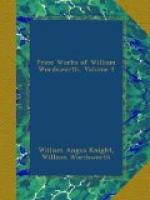(a) Letter to the Editor of ‘The Friend,’ signed Mathetes.
(b) Answer to the Letter of Mathetes, 1809.
‘Mathetes’ proved to be Professor JOHN WILSON, ’eminent in the various departments of poetry, philosophy, and criticism’ (’Memoirs,’ i. 423), and here probably was the commencement of the long friendship between him and WORDSWORTH. As a student of WILSON’S, the Editor remembers vividly how the ‘old man eloquent’ used to kindle into enthusiasm the entire class as he worked into his extraordinary lectures quotations from the ‘Excursion’ and ‘Sonnets’ and ‘Poems of the Imagination.’ Among the letters (vol. iii. p. 263) is an interesting one refering to ’Advice to the Young;’ and another to Professor WILSON (vol. ii. pp. 208-14).
III. OF EDUCATION.
(a) On the Education of the Young: Letter to a Friend, 1806.
(b) Of the People, their Ways and Needs: Letter to Archdeacon Wrangham, 1808.
(c) Education: Two Letters to the Rev. H.J. Rose, 1828.
(d) Education of Duty: Letter to Rev. Dr. Wordsworth, 1830.
(e) Speech on laying the Foundation-stone of the New School in the Village of Bowness, Windermere, 1836.
In these Letters and the Speech are contained WORDSWORTH’S earliest and latest and most ultimate opinions and sentiments on education. Agree or differ, the student of WORDSWORTH has in these discussions—for in part they have the elaborateness and thoroughness of such—what were of the substance of his beliefs. Their biographic importance—intellectually and spiritually—can scarcely be exaggerated, (a), (b), (c), (d) are from the ‘Memoirs;’ (e) is from the local newspaper (Kendal), being for the first time fully reprinted.
VOL. II.
AESTHETICAL AND LITERARY.
I. Of Literary Biography and Monuments.
(a) A Letter to a Friend of Robert Burns, 1816.
(b) Letter to a Friend on Monuments to Literary Men, 1819.
(c) Letter to John Peace, Esq., of Bristol, 1844.
These naturally group themselves together. Of the first (a), perhaps it is hardly worth while, and perhaps it is worth while, recalling that WILLIAM HAZLITT, in his Lectures upon the English Poets, attacked WORDSWORTH on this Letter with characteristic insolence and uncritical shallowness and haste. Under date Feb. 24th, 1818, Mr. H. CRABB ROBINSON thus refers to the thing: ’Heard part of a lecture by HAZLITT at the Surrey Institution. He was so contemptuous towards WORDSWORTH, speaking of his Letter about Burns, that I lost my temper. He imputed to WORDSWORTH the desire of representing himself as a superior man’ (vol. i. p. 311, 3d ed.). The lecture is included in HAZLITT’S published Lectures in all its ignorance and wrong-headedness; but it were a pity to lose one’s temper over such trash. His eyes were spectacles, not ‘seeing eyes,’ and jaundice-yellow, (b) and (c) are sequels to (a), and as such accompany it.




